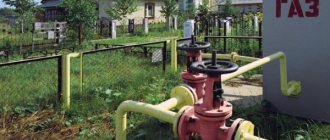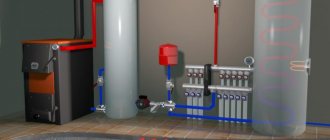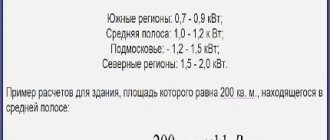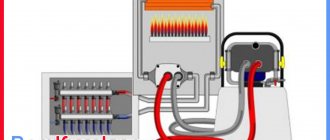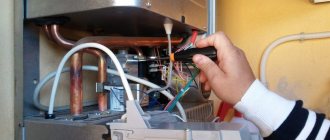Here you will learn:
- Distinctive features of an indirect heating boiler
- Types of gas boilers
- What is a single-circuit boiler
- Schemes for connecting a boiler to a single-circuit boiler
- What is a double-circuit boiler
Modern models of gas boilers with one circuit for heating the heating fluid could be called primitive water heating devices if they were not equipped with high-precision control and monitoring equipment to ensure the reliability and safety of all operating cycles. To solve the problems of regulation and safety of boilers, an automatic boiler protection system with gas flow and pressure regulators, fittings that regulate the flow, temperature and pressure of heated water, all kinds of sensors, instruments and safety devices is aimed. This is the main advantage of gas boilers.
Other important benefits:
- simplicity of design and installation of the boiler, which includes a combustion chamber with a gas burner, a loop heat exchanger in the firebox, a system of manifolds and pipelines, and pumping equipment;
- efficiency achieved by automation and adjustment work for optimal and efficient combustion of fuel, mixing processes and regulation of coolant parameters in accordance with standards;
- the ability to connect boilers to cascade heating systems within cities and large towns, which allows not only to centrally control the system, but also to ensure reliable and high-quality heat supply to consumers in residential areas, neighborhoods, microdistricts, as well as enterprises whose boiler houses are included in the cascade;
- more environmentally friendly emissions of gas combustion products into the atmosphere compared to similar boiler houses using liquid and solid fuels.
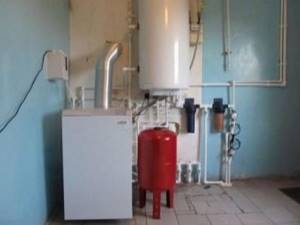
Distinctive features of an indirect heating boiler
A boiler is a large barrel whose main function is storage. It comes in different volumes and shapes, but its purpose does not change. Without a boiler, a problem may arise when using, for example, two showers or a shower and a kitchen tap at once.
If a household 2-circuit boiler with a power of 24-28 kW produces only 12-13 l/min per flow, and one shower requires 15-17 l/min, then when any additional tap is turned on, there will be a shortage of water supply. The boiler simply does not have enough working capacity to provide hot water to several points.

If a large storage tank is installed in the house, even with several water points turned on at the same time, everyone will be provided with hot water
All storage boilers can be divided into 2 large categories:
- direct heating, creating a supply of hot water using a heating element - for example, an electric heating element;
- indirect heating, heating water with already hot coolant.
There are other types of boilers - for example, conventional storage water heaters. But only volumetric storage devices can indirectly receive energy and heat water.
BKN, unlike energy-dependent equipment running on electric, gas or solid fuel, uses the heat generated by the boiler. Simply put, it does not require additional energy to function.
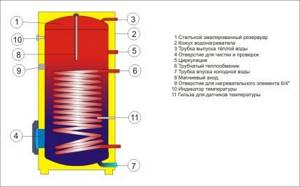
BKN design. Inside the tank there is a coil - a steel, brass or copper tubular heat exchanger that acts as a heating element. Heat inside the tank is retained according to the principle of a thermos
The storage device fits easily into the DHW system and does not cause problems during operation.
Users see many advantages in using BKN:
- the unit does not require electrical power and benefits from the economic side;
- hot water is always “ready”, there is no need to let cold water pass through and wait for it to heat up;
- Several water distribution points can operate freely;
- stable water temperature that does not drop during consumption.
There are also disadvantages: the high cost of the unit and additional space in the boiler room.
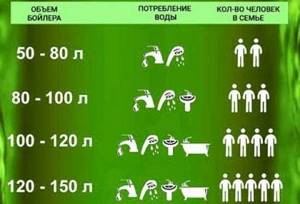
The volume of the storage tank is chosen based on the number of people permanently residing in the house. The smallest boilers are designed for 2 consumers, so when choosing, you can start from a volume of 50 liters
According to all characteristics, the BKN is suitable for use in conjunction with a gas boiler. Moreover, this is one of the best solutions for equipping a hot water preparation system for a private house with a large number of residents.
But boilers are different, so we will consider both acceptable options and those where problems may arise.
Types of gas boilers
Gas devices with an indirect heating boiler may differ in the type of placement and shape of the tank.
According to the principle of placement: wall and floor
Can be:
- wall;
- floor
Units of the first category are devices of small volume - up to two hundred liters.

A floor-standing gas boiler in a package, with an indirect heating boiler, is installed in a special room.
They are installed using special brackets on a stable wall that can support the weight of the water tank without loss. It is clear that flimsy plasterboard partitions are not suitable for this purpose. Typically, such devices are purchased by one small family for their private home.
The second ones are capacious water heaters designed for a large number of people. Such devices will require the installation of a special boiler room.
They are usually purchased by enterprises and owners of large cottages and estates.
According to the shape of the tank
- Horizontal: very bulky, but they do not require pumps; they themselves maintain the water in the required volume.
- Vertical: have a small capacity.
When choosing, you should take into account the number of people in the family, as well as the layout features and the availability of free space in the country house or in the house.
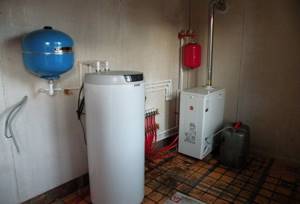
Gas floor-standing boiler installed in the boiler room and a small vertical expansion tank.
Important Buyer Tips
The experience of specialists involved in the development of heating systems powered by natural gas and conducting tests, including in our climatic conditions, will allow you to make the right choice. Just follow the tips below:
- When purchasing a small-sized boiler, be sure to look at the lower power value. If it slightly exceeds the calculated value, then it is worth purchasing a thermostat in addition. It will save money on equipment operation in the long term, and will also significantly increase the service life by reducing the number of equipment starts.
- The heat exchanger is known to suffer from one serious ailment, the deposition of salts and lime. To avoid this, in conditions of “hard” water, you should take equipment with bithermic heat exchangers. If the water undergoes pre-treatment, the so-called “softening”, then it is better that the heat exchanger is separate; in the first case you will reduce the formation of lime, and in the second you will save money.
- In the case of spruce, the house area is large, and the consumption of hot water is also high due to the large number of points of its consumption, it would be more advisable to purchase such a wonderful thing as a boiler. In some double-circuit boilers it is already present, but if not, then it must be added. The boiler will allow you to increase the consumption of hot water several times, so you will not experience a shortage of it.
Information!
It is important to remember that gas boilers are mostly designed to work with a central gas pipeline, but if there is no such thing, and it is necessary for the equipment to operate on liquefied gas, then be sure to notify the seller during setup and installation, use only the services of a qualified specialist, not expose yourself and your loved ones to unnecessary risk.
- Also, if there is a need to connect such things as heated floors, ventilation and other third-party circuits to the boiler, it is important to entrust the calculations and selection of components to a specialist.
- When purchasing a boiler, you should take care of purchasing and installing an automated control system in your home. Automatic controls will not only more than pay for themselves in the long run, but will also significantly reduce the cost of heating the premises. They work on the principle of adjusting and regulating the boiler power during daily operation. By purchasing an automated control system once, you can save about 20% on fuel, which will definitely affect your wallet.
The issue of heating a living space and providing hot water requires maximum responsibility and care. It is necessary to buy a wall-mounted gas double-circuit boiler with a boiler in specialized stores and centers with mandatory preliminary consultation. Otherwise, inattention and frivolity can lead to accidents and disastrous consequences. Only qualified specialists and consultants can guarantee the correct operation of such delicate equipment throughout its entire service life.
What is a single-circuit boiler
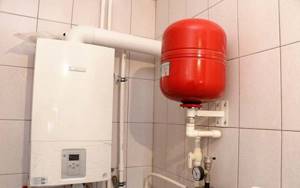
Single-circuit gas boilers are used to heat the coolant that fills the heating system. A single-circuit boiler does not prepare water for hot water supply. In rooms where the heated area sometimes exceeds three hundred square meters, floor-standing boilers are used. These heating devices are much more powerful than wall-mounted ones.
Wall-mounted single-circuit heating devices are most often used in high-rise apartments and can heat an area of up to three hundred square meters. These boilers are much more compact than floor-standing ones, and weigh just over 40 kilograms. The wall-mounted single-circuit boiler fits organically into the interior. Also, these wall-mounted devices are more functional than their floor-standing counterparts. The power of the most advanced models of wall-mounted single-circuit boilers is no more than 35 kilowatts.
A single-circuit gas boiler does not have any complex elements or mechanisms in its design. This boiler consists of:
- burners;
- heat exchanger;
- control unit;
- water pump;
- turbine electric motor (if the boiler has a closed combustion chamber);
- pressure gauge;
- sensors;
- shut-off valves.
Wall-mounted single-circuit boilers can be equipped with an expansion tank, which is hidden under the boiler casing. Also, the expansion tank can be part of a floor heating device, which has low power.
Operating principle of single-circuit boilers
Gas single-circuit boilers with an indirect boiler operate according to two main connection schemes. The principle of operation of the first is as follows:
- The three-way valve dominates here. A pump is installed directly into the outlet of the gas boiler, which provides circulation and creates pressure. The next step is to install a three-way valve, which is connected to the boiler thermostat. When heating tap water or other coolant, its flow is directed to the heating system, with priority for the hot fluid entering the boiler coil. This happens with the help of an additional, second pump. And it turns out that in this case the hot water supply and the heating system are connected in parallel, and they can form two circuits, precisely in this closed chain. And after the boiler, an additional pump is installed, which helps regulate the operation of the thermostat. The principle of starting and stopping the process is also regulated by a thermostat, namely, when the heating is strong, the fuel supply is forced to shut off, when the coolant cools down, the fuel is passed through again, and the burner is automatically ignited.
- If there is no double circuit and priority is not given to heating hot water, the boiler is mounted in a common system, installed in a convenient location, and water is heated along with all radiators.
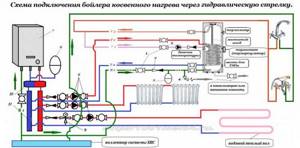
Manufacturers
Today, the leading manufacturers of gas boilers with a built-in boiler are: Electrolux, Ariston, Viessmann, Baxi, De Dietrich, Vaillant, Wolf, Chaffoteaux, Biasi.
| Manufacturer | Model | Characteristic |
| Electrolux | Electrolux GCB Magnum 28 Fi | Gas wall-mounted boiler with a 60-liter boiler . Power: 28.70 kW. Efficiency: 92.4%. Voltage: 220 V. Combustion chamber: closed. Number of circuits: dual circuit. Heat exchanger: separate. Dimensions (HxWxD): 900x600x460. |
| Ariston | Ariston Clas B Evo 24 FF | Wall-mounted gas boiler with built-in boiler. Power: 24.00 kW. Efficiency: 92.0%. Voltage: 220 V. Combustion chamber: closed. Number of circuits: dual-circuit (heating and hot water supply). Heat exchanger: separate. Dimensions (HxWxD): 943x600x460 |
| Ariston | Ariston Clas B Evo 30 FF | Storage capacity: 8 liters. Power: 30.00 kW. Efficiency: 92.0%. Voltage: 220 V. Combustion chamber: closed. Number of circuits: dual circuit. Heat exchanger: separate. Dimensions (HxWxD): 943x600x460 |
| Viessmann | Viessmann Vitopend 100-W WHKB025 | Storage capacity: 4 liters. Power: 25.10 kW. Efficiency: 90.0%. Voltage: 220 V. Combustion chamber: open. Number of circuits: dual-circuit (heating and hot water supply). Heat exchanger: separate. Dimensions (HxWxD): 725x450x360 |
| Viessmann | Viessmann Vitopend 100-W WHKB026 | Storage capacity: 4 liters. Power: 30.00 kW, efficiency: 90.0%. Voltage: 220 V. Combustion chamber: open. Number of circuits: dual-circuit (heating and hot water supply). Heat exchanger: separate. Overall dimensions (HxWxD): 725x450x360 |
| Baxi | Baxi Nuvola-3 B40 280i | Designed for heating private houses, cottages, country houses, cottages with an area of up to 280 m², as well as for organizing hot water supply. Features: 40 liter boiler; separate heat exchangers; weather-compensated automation; LCD display; push-button control; hydraulic group made of brass; expanded functionality; programming. |
| De Dietrich | De Dietrich MS 24 | Wall-mounted gas boiler with a storage tank of 6 liters. Power: 24.00 kW. Efficiency: 91.0%. Voltage: 220 V. Combustion chamber: open. Number of circuits: single-circuit. Heat exchanger: separate. Overall dimensions (HxWxD): 730x400x299 |
You can read about Biasi gas boiler models with a built-in boiler here.
Thus, by purchasing a gas boiler with a built-in boiler, you can achieve significant cost savings without losing functionality and ease of use.
Schemes for connecting a boiler to a single-circuit boiler
There are three ways to connect the boiler to the boiler.
Direct connection of the water heater to the heating system
In this embodiment, the BKN is included in the heating system, in series or in parallel with other radiators. The simplest and most ineffective scheme is not recommended for use and is given for reference.

Scheme of direct connection of a water-heating gas single-circuit boiler to the heating system.
If the boiler temperature is set below 60 °C, this scheme becomes even less economical, and the water takes a very long time to heat up.
Temperature increase
A three-way valve is added to the connection diagram - a special device that switches the movement of the coolant when the temperature in the water heater tank drops to DHW and vice versa.

Thus, if the DHW water cools down, the heating is temporarily turned off. All boiler power is redirected to DHW. The temperature on the device in this scheme is set higher (usually 80–90 °C). And the heating temperature is regulated by a three-way valve.
Reference! The boiler temperature must be set 5 °C above the required DHW water.
Using a thermostat in a water heater and automation
If a thermostat is installed in the BKN (a device that gives a signal when a set temperature is reached), and the boiler controller has contacts for connecting the boiler thermostat, then this circuit is the most preferable.
In this case, the boiler electronics know about the temperature of the water in the DHW system, and it decides where to direct its power: to heat water in the BKN or for heating.
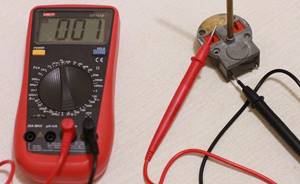
Thermostat for a water heater in a heating system, with it you can find out data on the water temperature.
What is a double-circuit boiler
This heating device not only heats the coolant, but is also intended for preparing hot water. A double-circuit boiler has a more complex structure than its single-circuit counterpart. The most complex device has a dual-circuit heating device, which is equipped with a three-way valve.
There are dual-circuit heating devices that are equipped with a pair of heat exchangers. One heat exchanger is responsible for heating water in the heating system, and the second heats water for water supply. The most rational design has dual-circuit heating devices that are equipped with a bithermic heat exchanger. Such a heat exchanger is two in one. Inside the bithermic heat exchanger there is another heat exchanger, which is designed to heat water for domestic purposes. But boilers with separate heat exchangers are considered more popular models.
Double-circuit gas boilers are good because they solve all the problems associated with preparing hot water for heating a room. Such heating devices are quite compact and fit organically into any interior. The design of a double-circuit heating device resembles the design of its single-circuit counterpart, which is also supplemented:
- a second heat exchanger (if the boiler design provides for this);
- 3-way valve (if the heat exchanger is not bithermic);
- inlet and outlet for the DHW pipeline.
Advantages and disadvantages
The absolute advantages of boilers with indirect heating heaters include savings on electricity.
No atmospheric burner or power source is required, as with direct heating devices. The heating system will do everything itself, which significantly reduces waste of money.
- Productivity: a tank with a capacity of one hundred liters produces approximately 400 liters of hot water per hour.
- Virtually instant hot water supply.
- Possibility of using multiple energy sources, for example, a geothermal system.
- Democratic price.
- Simplicity in the device.
- The warm-up speed, even in new models, will not be instantaneous.
- Massiveness.
Attention! If the family is very tall, then one room will need to be given over to the boiler room, displacing itself. Small models will not solve the problem of washing.
Placement of a double-circuit boiler
The main purpose of double-circuit boilers is in small houses and apartments, where the equipment is located near the kitchen, but not far from the bathroom. Short distances are a necessity for this type of boiler; the shorter the path of hot water to the consumer, the better, so that you don’t have to wait too long for hot water to flow.
Experts believe that the maximum distance from the heating circuit to the tap is 7 meters. Anything more and it all just becomes wasteful. The usual distances are from 1.5 to 3 meters. But the priority placement is the kitchen, where the hot tap opens frequently.
Introduction of a boiler into the DHW circuit
First, let's consider the option when the boiler is integrated into the DHW circuit. From a hydraulic point of view everything looks correct. A three-contact mechanical thermostat, placed in the boiler body, closes the power supply circuit to the pump when the temperature drops.
That, in turn, begins to pump water, which circulates along the circuit between two heat exchangers: it is heated by a gas burner, and then moves to the BKN coil.
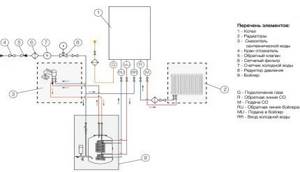
Simply put, both devices perform their functions: the boiler stops heating and begins to heat water for hot water supply, and the boiler tries to heat the contents of its “storage” due to the increased temperature of the hot water.
The problem arises precisely because of the mismatch of temperature parameters. Let's assume that the initial filling temperature of the boiler is +15˚С, and the recommended temperature for heating water in the boiler is +60˚С - the automatic limiter no longer allows.
The difference between the two set parameters of 45˚ is significant, so the heat exchange in the boiler occurs quite intensively. But the temperature begins to rise, and when it reaches +40˚С, the difference is much smaller - only 20˚. Accordingly, heat transfer slows down.
Don't forget that water continues to circulate between the two devices. The gas burner of the boiler begins to receive not a 15-degree coolant from the cold water system, as recommended by the manufacturer, but a 40- and then 50-degree heated liquid from the boiler.
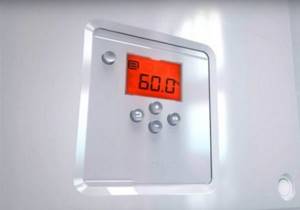
As a result, the temperature of the liquid instantly soars to +60˚С, the sensor is triggered, the burner turns off, as it is programmed for parameters that are safe for consumers
The water in the boiler begins to cool - the sensor turns on again and the circulation process resumes. And so on all the time. This leads to the fact that the water in the boiler does not reach the required temperature, but remains insufficiently hot, which is not suitable for domestic hot water use.
The process of interaction between the two units could take place if the boiler burner heated the coolant to +80˚C, but this is prohibited by the instructions to protect users from burns.
Another reason not to use the BKN and DHW circuit of a gas boiler in steam lies in the inability to heat the water in the boiler to a temperature exceeding +60˚C. This is due to sanitary standards.

About once a week, the device is filled with hot water at about 70-75˚C, so that the legionella bacterium, whose colonies resemble mucus, does not multiply in the tank. A large number of bacteria in water leads to the development of allergies and other diseases
It can be concluded that due to only two, but significant reasons, the scheme of combining a gas boiler and BKN through a hot water supply circuit was recognized as ineffective and unsafe. If you already have a double-circuit boiler, just use it for its intended purpose: use one circuit for the heating system, the second for DHW.
Interaction of BKN with the heating circuit
The second option is the interaction of the BKN with the heating circuit. The technical solution works great if the performance of the gas boiler is not enough, and this is the only effective way to connect the BKN to a 2-circuit boiler.
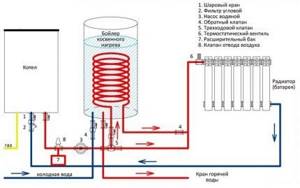
We do not touch the hot water circuit, but use only the branch responsible for heating - that is, going to the radiators and the “warm floor” system. The pipe leading to the boiler must be connected immediately under the boiler, after the tap
With electronic control, you need to set the boiler to heat water at +70°C - this is the coolant that will flow into the boiler, where further temperature adjustment will take place. The thermostat located in the boiler will turn on the pump when the temperature drops, and turn it off when the required value is reached.
With mechanical control of a gas boiler, everything happens differently. A second thermostat, the boiler, is connected to the boiler thermostat, and then the first device can be controlled using the second. For example, if you set the temperature on the second one to +80°C, then the first one, the worker, will require heating the water to +80°C, regardless of what temperature it is set to.
When the water in the boiler heats up to the required temperature, the second thermostat breaks the circuit, and the first one, located on the boiler, again becomes the “main” thermostat. If at this moment the temperature is set to +40°C, then it will drop to 40.
Gas boiler with boiler: how to choose and connect
The desire of every homeowner to provide their home with the necessary sanitary conditions and amenities without overpaying for it is quite understandable. It does not always make sense to organize a separate hot water system when there are simpler integrated solutions, for example, a gas boiler with a boiler. The main thing is to correctly calculate the required amount of water for household needs and select a unit of appropriate capacity.
Types of layouts
The advantages and disadvantages of double-circuit gas boilers are well known; they are good enough to serve 2-3 small consumers. But what if there are more consumers and the use of electric water heaters is excluded? There are several modern solutions for this:
- Wall-mounted gas boilers with built-in boiler.
- Heating installations with a remote storage tank for hot water.
- Indirect heating boilers.
Practice shows that for a family of 3 people, for household and sanitary needs, it is enough to have a capacitive electric heater with a capacity of 50 liters in the house. Of course, this means using hot water within reasonable limits. In order not to purchase such a heater and not to deal with laying extra cables and pipelines, you just need to choose a wall-mounted heating unit, inside of which there is a tank with a capacity of 46-50 liters. Its design is two in one: a gas boiler with an indirect heating boiler inside. The principle of operation is also preserved: one part of the coolant goes into the heating system of the house, and the other into the coil of the internal boiler. Having reached a certain temperature of the water in the tank, which is determined by the sensor, the entire volume of the coolant is switched to heating the house.
1 – fan – smoke exhauster; 2 – heat exchanger with increased productivity; 3 – combustion chamber; 4 – storage tank made of stainless steel; 5 – control unit with display.
The heater design includes 2 circulation pumps, one pumps coolant through the heating system, and the second through the boiler coil, while the burner operates at maximum to quickly heat the water in the tank. Later, the circuit switches to maintaining water temperature, which reduces fuel consumption.
For reference: a VIESSMANN suspended boiler with a power of 12.5 kW with a built-in tank with a capacity of 46 liters can provide a nominal hot water output of about 14 l/min when heated from +10ºС to +40 ºС.
More powerful wall-mounted gas boilers are equipped with containers of greater capacity, but usually it does not exceed 100 liters.
Solution with a remote storage tank
14 liters or one and a half buckets of hot water for one minute is a good indicator, but it is not always enough. The dimensions of suspended heat generators are limited, so they cannot accommodate large volume vessels. But it is the amount of heated water in reserve that determines the long-term performance of the hot water supply system. And the weight of the structure along with the water will eventually become such that not a single wall can support it.
Many manufacturers offer heating units with a built-in tank in a floor-standing design, but significantly increasing their size in order to place a large container inside also does not make sense. When you need greater productivity, you should pay attention to remote vessels for hot water.
- A – thermal insulation made of polyurethane foam;
- B – connection to the water supply;
- C – hot water output;
- D – heating coil located in the lower part of the vessel;
- E – stainless steel vessel;
- F – technological opening for maintenance.
Such remote boilers with a capacity of up to 500 liters can be connected to heat generators that provide this capability. That is, to connect a separate vessel, the unit must have outlet pipes, and inside there must be a circulation pump servicing the DHW circuit. In this case, the power of the gas boiler needs to correspond to the capacity of the vessel, otherwise the water in it will never reach normal temperature for use.
The fact is that the controller that controls the entire circuit gives priority to the heating system. If the temperature of the coolant in the system circuits drops to the lower limit, the control unit will direct all the power of the installation to increase this temperature, and then to the DHW circuit. In this situation, you can use the functions of the controller by programming the preparation of water at the required temperature for a certain time of day.
Connection diagram for an indirect heating boiler
Only a full-fledged indirect heating boiler, equipped with an additional insert for electric water heating, will help solve all the problems with an insufficient amount of hot water or its underheating. This solution will always maintain the hot water temperature at a given level.
- A – protective magnesium electrode;
- B – metal vessel with enamel coating;
- C – polyurethane foam insulation;
- D – heating element in the form of a coil.
In this case, you will have to connect an external boiler for a gas boiler according to a circuit with a circulation pump. One of the leading manufacturers of heating equipment, VIESSMANN, offers the following scheme for connecting a free-standing tank to a home DHW circuit:
A – hot water outlet; B – circulation circuit; C – circulation pump; D – check valve; E – discharge into the sewer; F – safety valve; G – valve; N – valve – flow regulator; K – boss for pressure gauge; L – check valve; M – emptying the system; N – connection to the water supply network; S – expansion tank of the DHW circuit.
The electric heater is supplied by the manufacturer as an option; it must be connected to the electrical network and connected to the boiler installation controller.
Conclusion
The use of gas boilers with a boiler is one of the best comprehensive solutions for providing a private home with heating and hot water at reasonable costs. For this reason, they are gaining more and more popularity among homeowners, relegating flow-through heat exchangers of double-circuit units to the background.
cotlix.com
